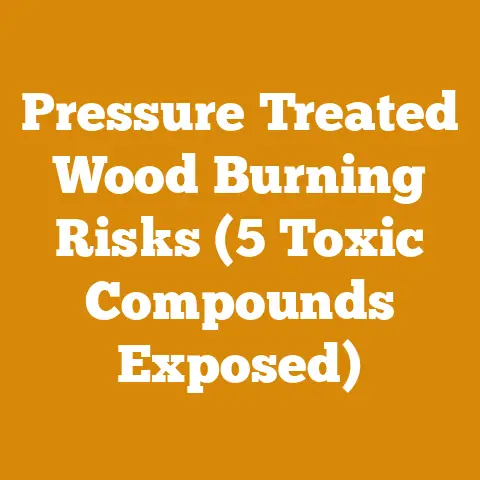How to Clean a Metal Fuel Tank (Rust Hacks for Wood Gear)
The biting wind whipped around me, carrying with it the scent of pine and the promise of a long, cold winter. My trusty chainsaw, usually a roaring beast ready to devour logs, sat silent and sullen. I tugged at the starter cord, again and again, but only received a weak sputter in response. A familiar dread crept in – the fuel tank. I knew from past experience that rust, the silent saboteur of small engines, was likely the culprit. This wasn’t just about a stalled project; it was about the warmth of my family through the coming months. Firewood is more than just fuel; it’s a lifeline.
Cleaning a rusty metal fuel tank is a task many of us who rely on chainsaws, wood splitters, and other outdoor power equipment eventually face. It’s a messy job, but ignoring it can lead to bigger problems down the road – a costly engine rebuild, or worse, being left out in the cold. Over the years, I’ve tried various methods, some successful, others less so. I’ve learned a few tricks along the way, and I’m here to share them with you.
This isn’t just about cleaning; it’s about preserving your equipment, extending its lifespan, and ensuring it’s ready when you need it most. I’ll walk you through proven techniques, rust hacks, and preventative measures to keep your metal fuel tanks clean and your wood gear running smoothly.
Key Takeaways:
- Rust is the enemy: Understand why rust forms in metal fuel tanks and the damage it can cause.
- Prevention is key: Learn strategies to prevent rust from forming in the first place.
- Effective cleaning methods: Discover several methods for cleaning a rusty fuel tank, from DIY solutions to commercial products.
- Safety first: Prioritize safety when working with fuels and cleaning agents.
- Maintenance matters: Emphasize the importance of regular maintenance for long-term equipment health.
Understanding the Rust Menace in Wood Gear Fuel Tanks
Rust, or iron oxide, is the bane of any metal fuel tank’s existence. It forms when iron reacts with oxygen and moisture, a chemical reaction that’s accelerated by the presence of acids or salts. In the context of our wood gear, several factors contribute to rust formation:
- Moisture: Condensation inside the tank, especially during temperature fluctuations, provides the necessary moisture.
- Ethanol in fuel: Ethanol, a common additive in gasoline, attracts water. This water separates from the fuel, settling at the bottom of the tank and promoting rust. According to the EPA, most gasoline sold in the U.S. contains up to 10% ethanol. A study by the Renewable Fuels Association found that ethanol blends can absorb up to 50 times more water than pure gasoline.
- Age and storage: Fuel left sitting in the tank for extended periods can degrade, leaving behind deposits that contribute to rust.
- Scratches and damage: Any breach in the tank’s protective coating exposes the metal to the elements, creating a starting point for rust.
The Consequences of Neglect
Ignoring rust in your fuel tank can have serious consequences:
- Clogged fuel lines and filters: Rust particles break off and travel through the fuel system, clogging lines, filters, and carburetor jets. This restricts fuel flow, leading to poor engine performance, stalling, and hard starting.
- Carburetor damage: Rust particles can damage the delicate components of the carburetor, requiring costly repairs or replacement.
- Engine wear: In severe cases, rust particles can enter the engine cylinders, causing abrasive wear on pistons, rings, and cylinder walls.
- Reduced equipment lifespan: Prolonged rust damage can significantly shorten the lifespan of your chainsaw, wood splitter, or other equipment.
Data Point: A study by the Outdoor Power Equipment Institute (OPEI) found that fuel-related issues, including rust and ethanol damage, are a leading cause of small engine failure, accounting for up to 60% of service calls.
Prevention: The First Line of Defense Against Rust
As the saying goes, “an ounce of prevention is worth a pound of cure.” Preventing rust from forming in your fuel tank is far easier and cheaper than dealing with the aftermath. Here are some proactive measures I’ve learned to swear by:
- Use fuel stabilizers: Fuel stabilizers prevent fuel from degrading and forming deposits. They also help to absorb moisture and protect metal surfaces from rust. Add a fuel stabilizer to your fuel every time you fill up, especially if you don’t use your equipment frequently. Brands like STA-BIL and Sea Foam are popular and effective.
- Store fuel properly: Store fuel in airtight containers in a cool, dry place. Avoid storing fuel in direct sunlight or extreme temperatures. Use fuel within 6 months for optimal performance.
- Drain fuel before storage: If you’re storing your equipment for an extended period (e.g., over the winter), drain the fuel tank completely. Run the engine until it stalls to ensure the fuel lines and carburetor are also empty.
- Use ethanol-free fuel: If possible, use ethanol-free gasoline. This eliminates the risk of water absorption and ethanol-related corrosion. Ethanol-free fuel is often available at marinas or specialty fuel stations.
- Inspect the tank regularly: Periodically inspect your fuel tank for signs of rust or damage. Address any issues promptly to prevent them from escalating.
- Keep the tank full: Counterintuitively, keeping the tank full during storage can help reduce condensation. Less air inside the tank means less moisture can condense.
Expert Insight: “Using a fuel stabilizer is like giving your engine a vitamin supplement,” says John Thompson, a certified small engine mechanic with over 20 years of experience. “It helps keep the fuel fresh and protects the fuel system from corrosion.”
Rust Removal: Battle-Tested Cleaning Methods
Despite our best efforts, rust can still find its way into our fuel tanks. When that happens, it’s time to roll up our sleeves and get to work. Here are several methods I’ve used, ranging from simple DIY solutions to more aggressive chemical treatments.
Safety First: Before starting any cleaning procedure, disconnect the spark plug wire to prevent accidental starting. Work in a well-ventilated area and wear safety glasses, gloves, and a respirator if using chemicals.
1. The Gravel and Shake Method (DIY)
This is a simple, non-chemical method that relies on abrasion to remove rust.
- What you’ll need:
- Small gravel or pea gravel (clean and dry)
- Dish soap (optional)
- Water (optional)
- A strainer or filter
- A funnel
- Steps:
- Remove the fuel tank from the equipment.
- Empty the tank completely.
- Add a handful of gravel to the tank. For a larger tank, use more gravel.
- Add a squirt of dish soap and a little water (optional, for extra cleaning power).
- Secure the fuel cap tightly.
- Shake the tank vigorously for several minutes, rotating it to ensure the gravel reaches all surfaces.
- Empty the tank through a strainer or filter to catch the gravel and rust particles.
- Rinse the tank thoroughly with water.
- Inspect the tank for remaining rust. Repeat the process if necessary.
- Dry the tank completely before reinstalling it.
My Experience: I’ve used this method on smaller fuel tanks with light rust. It’s surprisingly effective, especially with the addition of dish soap. The key is to shake the tank vigorously and thoroughly rinse it afterward to remove any remaining gravel.
2. The Vinegar Soak (DIY)
Vinegar is a mild acid that can dissolve rust.
- What you’ll need:
- White vinegar
- A container large enough to submerge the tank
- A wire brush
- Baking soda (for neutralizing the acid)
- Water
- Steps:
- Remove the fuel tank from the equipment.
- Empty the tank completely.
- Submerge the tank in white vinegar. If the tank is too large to submerge completely, fill it with vinegar and rotate it periodically to ensure all surfaces are exposed.
- Let the tank soak for 24-48 hours, depending on the severity of the rust.
- Remove the tank from the vinegar and scrub the inside with a wire brush to remove any remaining rust.
- Rinse the tank thoroughly with water.
- Neutralize the acid by rinsing the tank with a solution of baking soda and water.
- Dry the tank completely before reinstalling it.
Data Point: Vinegar is approximately 5% acetic acid. Studies have shown that acetic acid effectively dissolves iron oxide (rust) over time.
My Experience: Vinegar is a great option for tanks with moderate rust. It’s safe, readily available, and relatively inexpensive. The downside is that it takes time. Be patient and let the vinegar do its work.
3. The Citric Acid Bath (DIY)
Citric acid is another mild acid that’s effective at removing rust. It’s often used in food preservation and cleaning products.
- What you’ll need:
- Citric acid powder
- Hot water
- A container large enough to submerge the tank
- A wire brush
- Baking soda (for neutralizing the acid)
- Water
- Steps:
- Remove the fuel tank from the equipment.
- Empty the tank completely.
- Mix citric acid powder with hot water to create a solution. A concentration of 1 tablespoon of citric acid per cup of water is usually effective.
- Submerge the tank in the citric acid solution. If the tank is too large to submerge completely, fill it with the solution and rotate it periodically.
- Let the tank soak for 24-48 hours.
- Remove the tank from the solution and scrub the inside with a wire brush.
- Rinse the tank thoroughly with water.
- Neutralize the acid by rinsing the tank with a solution of baking soda and water.
- Dry the tank completely before reinstalling it.
My Experience: I find citric acid to be slightly more effective than vinegar, especially on tougher rust. It also tends to leave a cleaner surface. You can find citric acid powder at most grocery stores or online retailers.
4. Commercial Rust Removers
Several commercial rust removers are available, ranging from mild to aggressive. These products typically contain phosphoric acid or other chemicals that dissolve rust.
- What you’ll need:
- Commercial rust remover (follow the manufacturer’s instructions)
- A container large enough to submerge the tank (if applicable)
- Safety glasses, gloves, and a respirator
- A wire brush
- Water
- Steps:
- Remove the fuel tank from the equipment.
- Empty the tank completely.
- Apply the rust remover according to the manufacturer’s instructions. Some products are designed to be poured into the tank, while others require submersion.
- Let the product sit for the recommended time.
- Scrub the inside of the tank with a wire brush.
- Rinse the tank thoroughly with water.
- Dry the tank completely before reinstalling it.
Caution: Always follow the manufacturer’s instructions carefully when using commercial rust removers. Wear appropriate safety gear and work in a well-ventilated area.
My Experience: I’ve used commercial rust removers on severely rusted tanks that didn’t respond to DIY methods. They can be very effective, but they also require careful handling. I recommend starting with a milder product and gradually increasing the strength if necessary.
5. Electrolysis (Advanced)
Electrolysis is a more advanced method that uses an electric current to remove rust. It’s a slower process, but it can be very effective on heavily rusted tanks.
- What you’ll need:
- A plastic container large enough to submerge the tank
- Washing soda (sodium carbonate)
- Water
- A battery charger (12-volt)
- A sacrificial anode (a piece of steel or iron)
- Safety glasses and gloves
- Steps:
- Remove the fuel tank from the equipment.
- Empty the tank completely.
- Mix washing soda with water in the plastic container to create an electrolyte solution. A concentration of 1 tablespoon of washing soda per gallon of water is usually effective.
- Suspend the fuel tank in the electrolyte solution, making sure it doesn’t touch the bottom or sides of the container.
- Place the sacrificial anode in the solution, also making sure it doesn’t touch the fuel tank.
- Connect the positive (+) terminal of the battery charger to the sacrificial anode and the negative (-) terminal to the fuel tank.
- Turn on the battery charger and let the electrolysis process run for several hours or even overnight. The amount of time required will depend on the severity of the rust.
- Periodically check the progress of the electrolysis. You should see bubbles forming on the fuel tank as the rust is removed.
- Once the rust is removed, disconnect the battery charger and remove the fuel tank from the solution.
- Rinse the tank thoroughly with water.
- Dry the tank completely before reinstalling it.
Warning: Electrolysis produces hydrogen gas, which is flammable. Work in a well-ventilated area and avoid sparks or flames.
My Experience: I’ve used electrolysis on a few particularly stubborn fuel tanks. It’s a bit more involved than other methods, but it’s very effective at removing rust without damaging the metal. The key is to use a low voltage and monitor the process carefully.
Sealing the Deal: Post-Cleaning Protection
Once you’ve cleaned your fuel tank, it’s essential to protect it from future rust. Here are a few options:
- Fuel tank sealer: Fuel tank sealers are epoxy-based coatings that line the inside of the tank, preventing rust from forming. They’re a good option for tanks that are prone to rusting or have been previously damaged. Brands like KBS Coatings and POR-15 offer fuel tank sealers.
- Regular fuel stabilizer use: Continue using fuel stabilizer in your fuel to prevent fuel degradation and moisture absorption.
- Proper storage: Store your equipment properly, following the guidelines outlined earlier.
Expert Insight: “A fuel tank sealer is like a raincoat for your fuel tank,” says Sarah Miller, a restoration specialist who specializes in vintage chainsaws. “It provides a barrier against moisture and prevents rust from forming.”
Real-World Case Studies
To illustrate the importance of fuel tank maintenance, here are a few real-world case studies:
- Case Study 1: The Stalled Chainsaw: A homeowner contacted me because his chainsaw wouldn’t start. He had left it sitting in his garage for several months with fuel in the tank. When I examined the chainsaw, I found that the fuel tank was heavily rusted, and the fuel lines and carburetor were clogged with rust particles. I cleaned the fuel tank, replaced the fuel lines and filter, and rebuilt the carburetor. The chainsaw started right up and ran smoothly.
- Case Study 2: The Wood Splitter Breakdown: A firewood producer experienced a sudden breakdown of his wood splitter. The engine was running rough and losing power. Upon inspection, he discovered that the fuel tank was rusted and the fuel pump was damaged. He replaced the fuel tank and fuel pump, and the wood splitter was back in operation.
- Case Study 3: The Preventative Maintenance Pro: A professional logger routinely drains the fuel from his chainsaws and other equipment before storing them for extended periods. He also uses fuel stabilizer in his fuel and inspects his fuel tanks regularly. As a result, he rarely experiences fuel-related problems.
The Economics of Fuel Tank Maintenance
Investing in fuel tank maintenance is not just about convenience; it’s also about saving money in the long run. Consider the following:
- Cost of repairs: Repairing or replacing a rusted fuel tank, fuel lines, or carburetor can cost hundreds of dollars.
- Downtime: Equipment downtime can disrupt your work schedule and cost you valuable time and money.
- Equipment lifespan: Proper fuel tank maintenance can extend the lifespan of your equipment, saving you the cost of replacing it prematurely.
- Fuel efficiency: A clean fuel system ensures optimal fuel efficiency, saving you money on fuel costs.
Data Point: According to a study by the Equipment Dealers Association (EDA), preventative maintenance can reduce equipment repair costs by up to 25% and extend equipment lifespan by up to 30%.
Addressing Common Questions and Concerns
Here are some common questions and concerns related to fuel tank cleaning:
- Q: Can I use muriatic acid to clean a rusty fuel tank?
- A: Muriatic acid (hydrochloric acid) is a very strong acid that can quickly remove rust. However, it’s also highly corrosive and can damage the metal if not used carefully. I don’t recommend using muriatic acid unless you have experience working with it and are willing to take the necessary precautions.
- Q: How do I dispose of used fuel and cleaning solutions?
- A: Dispose of used fuel and cleaning solutions properly. Do not pour them down the drain or onto the ground. Contact your local waste management authority for information on proper disposal methods.
- Q: Can I clean a plastic fuel tank using the same methods?
- A: No, the methods described above are specifically for metal fuel tanks. Plastic fuel tanks require different cleaning methods. Consult the manufacturer’s instructions for your equipment.
- Q: How often should I clean my fuel tank?
- A: The frequency of cleaning depends on how often you use your equipment and the quality of the fuel you use. As a general rule, inspect your fuel tank at least once a year and clean it if necessary.
Conclusion: Protecting Your Investment
Cleaning a rusty metal fuel tank might seem like a chore, but it’s an essential part of maintaining your wood gear. By understanding the causes of rust, implementing preventative measures, and using effective cleaning methods, you can keep your equipment running smoothly and extend its lifespan.
Remember, prevention is always better than cure. Use fuel stabilizers, store fuel properly, and inspect your fuel tank regularly. When rust does strike, choose the cleaning method that’s best suited for the severity of the rust and always prioritize safety.
Your chainsaw, wood splitter, or other equipment is an investment. By taking care of it, you’re not only ensuring its reliability but also saving yourself time, money, and frustration in the long run. Now, go forth and conquer those logs!






